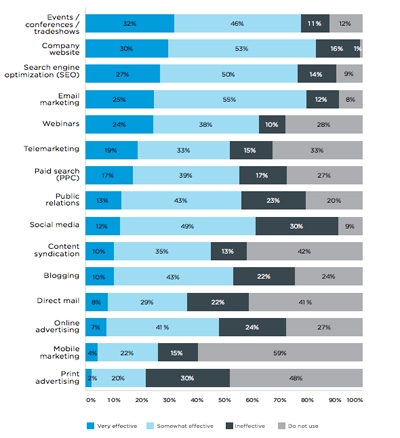 Email marketing is the
fourth most effective and second most common B2B lead-generation tool, according to a B2B Lead Generation Trend Report released Tuesday.
Email marketing is the
fourth most effective and second most common B2B lead-generation tool, according to a B2B Lead Generation Trend Report released Tuesday.
The
report, sponsored by BrightTALK and conducted by the B2B
Technology Marketing Community on LinkedIn, surveyed over 600 marketers to “better understand how B2B marketers are adjusting to new challenges, and to identify new trends and best
practices,” stated Holger Schulze, group founder of the Technology Marketing Community on LinkedIn.
Twenty-five percent of respondents stated
that email marketing was a “very effective” B2B lead generation tactic and 55% of respondents stated that it was a “somewhat effective” tool. Only 12% of marketers believe
email marketing is ineffective.
advertisement
advertisement
Email marketing was the second most widely used strategy, with 92% of respondents admitting they incorporated email
into their lead generation campaigns. A company’s Web site ranked first, with 99% of respondents using it for lead generation.
When asked what
email tactics they consider the most effective, marketers responded that content and personalization practices were the most popular strategies.
According to the report, the 10 most effective email tactics are:
- Compelling content for each stage of the buying process (56%)
- Offering downloadable content (49%)
- Segment email based on behavior
(45%)
- Automatically send email based on triggers (33%)
- Dynamically personalize email content (32%)
- Segment email campaigns based on
demographics (30%)
- Allow subscribers to specify email preferences (19%)
- Include surveys, trivia or games (12%)
- Use animated images
or video in design (11%)
- Use loyalty/rewards programs (10%)
Although email marketing ranks
as the fourth most successful lead-generation tool for B2B businesses in the BrightTALK report, email marketing is the #1 most effective lead-generation tool for small and medium-sized
businesses, according to a recent study by Ascend2 and Allegra Networks.
Email marketing’s ease of use and cost-effectiveness is perfect for smaller companies, while larger
B2B organizations have the resources to incorporate additional methods into their lead generation efforts.